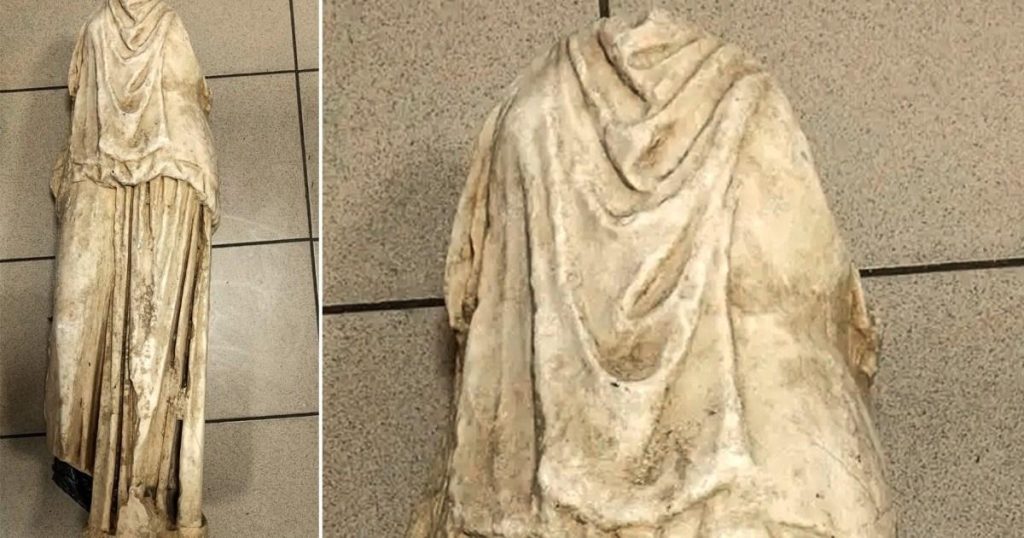A Hellenistic Treasure Unearthed from the Trash: An Unexpected Archaeological Discovery in Thessaloniki
The bustling metropolis of Thessaloniki, Greece, recently became the backdrop for an extraordinary archaeological find—a marble statue, believed to be over 2,000 years old, discarded in a rubbish bag. This astonishing discovery serves as a potent reminder of Greece’s rich historical tapestry, where echoes of the past frequently intersect with the present. The statue, a headless depiction of a woman draped in a robe, was stumbled upon by a resident of Neoi Epivates, a town located just outside Thessaloniki. The individual, recognizing the potential historical significance of the artifact, promptly alerted local authorities, who then contacted archaeological experts to assess its age and provenance.
Preliminary examinations conducted by the experts revealed that the statue likely dates back to the Hellenistic era, a period spanning from approximately 320 to 30 BC. This era, following the conquests of Alexander the Great, witnessed a remarkable flourishing of art, culture, and intellectual pursuits across the Mediterranean world. The Hellenistic period saw the fusion of Greek culture with the traditions of the conquered territories, resulting in a unique blend of artistic styles and philosophical ideas. The statue, though damaged, potentially represents a tangible connection to this vibrant period of artistic expression.
Following the initial assessment, the statue was transferred to local antiquities authorities for further examination and preservation. Preservation efforts will likely focus on stabilizing the marble, cleaning the surface to reveal any obscured details, and potentially conducting further analysis of its composition and craftsmanship to gain deeper insights into its origins and artistic context. Concurrently, local police launched an investigation to ascertain the circumstances surrounding the statue’s abandonment. Although a man was briefly detained for questioning, he was subsequently released without charge. The investigation highlights the challenges in safeguarding cultural heritage and the complexities of balancing public safety with the preservation of historical artifacts.
This serendipitous discovery in Thessaloniki underscores the prevalence of accidental archaeological finds in Greece, a nation renowned for its ancient heritage. These unexpected encounters with the past often occur during construction projects, highlighting the pervasive presence of historical remains beneath the modern landscape. In December of the same year, workers installing natural gas pipelines near Athens unearthed a Roman-era statue of Hermes, buried upright in a brick-lined pit near the iconic Acropolis. This finding, like the statue in Thessaloniki, underscores the importance of vigilance and collaboration between construction crews and archaeological experts to ensure the preservation of these valuable artifacts.
Thessaloniki itself has been a hub of archaeological discoveries in recent years, particularly during the construction of its metro system, which officially opened in November. The extensive excavations undertaken during the metro’s construction unearthed a treasure trove of antiquities, revealing layers of history spanning from the ancient Greek period through the Byzantine and Ottoman empires. These discoveries offer invaluable insights into the city’s complex and multifaceted past. Key findings from the metro excavations, including a remarkably preserved marble-paved Roman thoroughfare and tens of thousands of smaller artifacts, are now prominently displayed within several subway stations, transforming these transit hubs into mini-museums. This innovative approach to showcasing archaeological discoveries integrates the past seamlessly into the fabric of modern city life, enriching the daily commute for residents and visitors alike.
The discovery of the Hellenistic statue, abandoned and then rescued from obscurity, encapsulates the ongoing narrative of archaeological discovery in Greece. It serves as a potent reminder of the enduring presence of the past and the importance of preserving these tangible links to history. While the exact circumstances surrounding the statue’s disposal may remain a mystery, its rediscovery provides a unique opportunity for scholars and the public to engage with the artistry and cultural context of the Hellenistic era. The ongoing investigation and subsequent preservation efforts will hopefully shed further light on the statue’s origins and significance, contributing to our understanding of this fascinating period in Greek history. Furthermore, the incident emphasizes the critical role of public awareness and cooperation between citizens and authorities in safeguarding the rich cultural heritage that permeates the Greek landscape.




